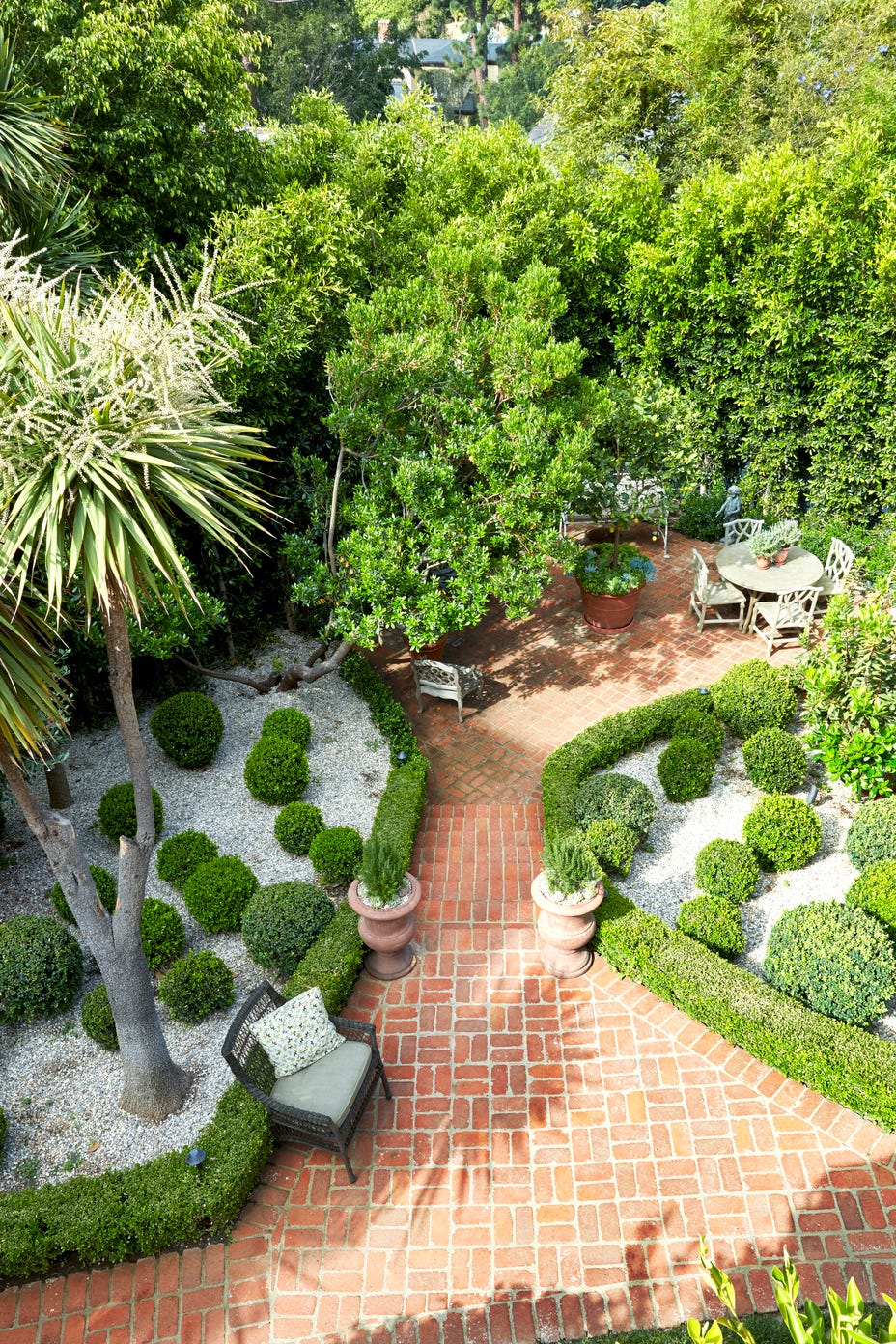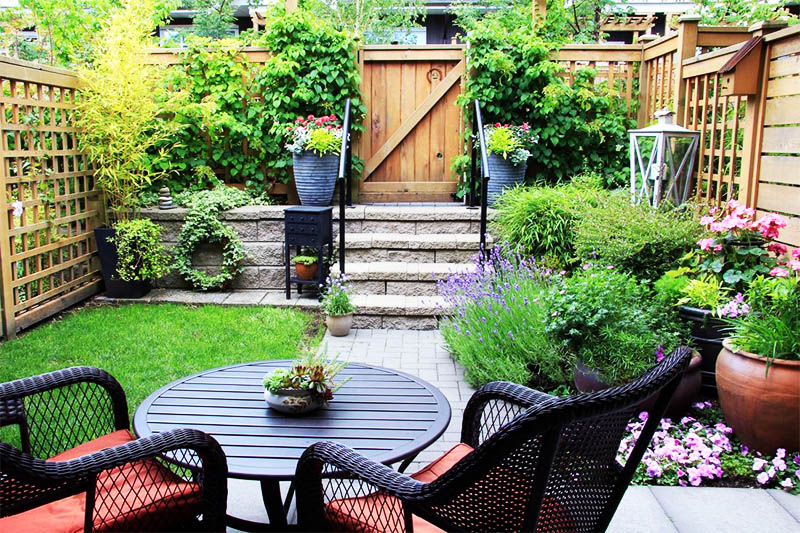5 Signs You Need a Professional Landscape Lighting Installer This Year
Discovering Various Types of Landscape Design to Boost Your Outdoor Atmosphere
Landscaping plays an important role in defining exterior spaces. Numerous designs, from typical yards to modern minimalist styles, offer unique benefits for enhancing looks and function. Including elements like xeriscaping and indigenous plants can contribute to eco-friendly balance. Understanding the interaction of hardscape and softscape is vital for developing welcoming settings. The selections available can be overwhelming, motivating one to review which style ideal aligns with their vision for an outdoor refuge.
Standard Yard Landscaping
:strip_icc()/back-yard-fire-pit-deck-bc1d716b-f8ac9935591e4699828efa7821bb6c17.jpg)
While several modern yards embrace minimalism and native plantings, standard garden landscape design remains a valued method that stresses balance, structure, and ornamental features. This style often includes formal geometric designs, where hedges, pathways, and flowerbeds are set up with precision. Central prime focus, such as water fountains or sculptures, attract the eye and offer a sense of harmony.Traditional landscape design frequently includes a variety of plant kinds, showcasing seasonal blooms and evergreen aspects. Traditional bushes, perennials, and annuals create vivid shades and textures throughout the year. Furthermore, trellises, arcs, and pergolas add vertical rate of interest and act as assistance for climbing up plants, enhancing the total aesthetic.The usage of natural products, such as stone and wood, further enriches the conventional landscape, adding to a classic top quality. Ultimately, this design welcomes relaxation and satisfaction, making it a cherished selection for those seeking a picturesque outside atmosphere.
Modern Minimalist Landscape Design
Modern minimalist landscape design stresses simpleness and performance, identified by open rooms and clean lines. Trick characteristics consist of a limited plant scheme and thoughtful hardscape style that focuses on functionality and visual charm. Reliable plant option approaches further enhance the minimalist technique, developing peaceful outside atmospheres that encourage relaxation and reflection.
Trick Attributes of Minimalism
An expanding fad in landscape design is the embrace of minimalism, identified by simplicity and functionality. Minimalist landscaping concentrates on tidy lines, open rooms, and a limited color palette, advertising a sense of serenity. Elements are carefully curated to stay clear of clutter, allowing each component to stand apart. Making use of all-natural products, such as rock and wood, enhances the organic feel while keeping an aesthetic balance. In addition, minimalist styles usually include geometric shapes, which can create aesthetic interest without frustrating the senses. Water attributes may be included, serving as prime focus that boost peacefulness. In general, minimalism in landscaping stresses the beauty of restriction, enabling nature's fundamental qualities to beam through in an unified outdoor environment.
Plant Choice Strategies
Effective plant option is necessary for achieving the wanted visual in modern-day minimalist landscaping. The emphasis should get on simpleness, utilizing a minimal palette of plants that enhance each other and the surrounding atmosphere. Indigenous plants are typically optimal, as they require less upkeep and water, advertising sustainability. Selecting species with varying structures and heights can add visual passion without frustrating the space. Grouping plants in collections rather than spreading them improves communication and reinforces the minimalist style. Evergreen ranges can give year-round structure, while seasonal blossoms present subtle shade changes. Ultimately, the goal is to produce a tranquil exterior room that symbolizes tranquility and harmony via thoughtful plant options.
Hardscape Design Principles
Vital elements in hardscape design significantly contribute to the total appearances and functionality of minimalist landscaping. This style approach highlights clean lines and understated materials, developing an uncluttered aesthetic experience. Secret elements include paths, patio areas, and preserving walls, which not just define spaces yet likewise boost ease of access and usability. The usage of materials such as concrete, rock, and wood is widespread, mirroring a natural yet modern visual. Including geometric forms and balanced formats better reinforces the minimalist approach, permitting an unified mix with bordering greenery. In addition, appropriate drain and erosion control are necessary considerations, making certain long life and sustainability. Ultimately, reliable hardscape design functions as a structure that enhances softscape elements while keeping equilibrium and simplicity in outdoor settings.
Cottage-Style Landscaping
Cottage-style landscape design supplies a wonderful technique to developing welcoming outdoor areas. By including charming plant combinations, this style promotes a feeling of warmth and whimsy. The emphasis on comfortable, distinct areas motivates leisure and satisfaction of nature.
Charming Plant Combinations
Although several homeowners look for to develop an attractive outdoor space, achieving the appeal of cottage-style landscape design often hinges on thoughtful plant combinations. Dynamic blooms, rich vegetation, and aromatic herbs can be skillfully combined to stimulate a feeling of fancifulness and nostalgia. Integrating lavender, daisies, and foxgloves develops a vivid tapestry that draws in pollinators while offering a fascinating scent. Including decorative turfs like miscanthus can include texture and movement, complementing the softer blossoms. Furthermore, blending seasonal and annual plants warranties constant shade throughout the periods. The usage of mountain climbers, such as clematis or honeysuckle, can boost vertical interest. In general, these combinations not only improve the landscape yet likewise foster a captivating and welcoming ambience.

Cozy Exterior Spaces
Creating cozy exterior rooms calls for a mindful blend of comfort and charm, complementing the vibrant plant combinations discovered in cottage-style landscape design - Landscape Lighting Installer. These locations usually include welcoming seating plans, such as weathered wooden benches or cushioned chairs surrounded by rich greenery. Soft illumination, like fairy lights or lanterns, includes heat, transforming the space into a serene retreat. Integrating elements such as trellises embellished with climbing up roses or great smelling natural herbs enhances sensory experiences. Additionally, pathways made from rustic stones welcome expedition and link with nature. Ornamental touches like birdbaths or whimsical garden art add to a sense of whimsy. Ultimately, the goal is to produce a captivating atmosphere that encourages leisure and enjoyment of the beauty surrounding these relaxing outdoor places
Xeriscaping for Water Conservation
How can next communities balance visual landscaping with the pushing requirement for water conservation? Xeriscaping becomes a sensible service, advertising lasting practices that decrease water usage while boosting outside charm. This landscaping approach concentrates on making use of drought-resistant plants indigenous to the region, which call for considerably much less water than typical gardens. By including compost and efficient irrigation systems, xeriscaping minimizes dissipation and runoff, further saving precious water resources.Communities can create visually attractive landscapes through careful preparation, choosing a varied variety of appearances and colors that thrive in dry problems. Furthermore, xeriscaping encourages the use of decorative rocks and decorative crushed rock, using functional and attractive choices to turf lawns. As communities welcome this eco-friendly strategy, they not only minimize their water intake yet additionally advertise biodiversity and resilience in their regional ecosystems. Eventually, xeriscaping works as a demo of the consistency in between visual allure and environmental duty.
Hardscape Layout Elements
Hardscape style aspects play an essential duty in boosting outside rooms by providing framework and performance. These non-plant functions, such as outdoor patios, wall surfaces, decks, and pathways, develop visual passion while offering functional purposes. Using products like rock, concrete, and block, hardscaping adds to the overall visual allure and durability of a landscape.Incorporating hardscape aspects can define locations within a lawn, directing movement and urging social interaction. For example, a well-placed path can link different areas of the yard, while preserving wall surfaces can handle altitude adjustments and avoid erosion.Furthermore, hardscape style can enhance availability and safety, providing stable surfaces for relaxing or strolling. Effective assimilation of hardscape elements enhances soft landscape design, making sure a well balanced exterior environment. Inevitably, thoughtful hardscape style boosts not only the charm of exterior spaces yet also their functionality, making them more inviting and useful for site visitors and house owners alike.
Outdoor Living Spaces
While outdoor living rooms use a seamless mix of convenience and nature, they act as crucial extensions of a home, enhancing way of living and leisure. These areas can include outdoor patios, decks, or exterior kitchens, developed to promote relaxation and enjoyment. Outdoor Lighting Installer. By including practical furnishings and elegant style, homeowners develop inviting environments for gatherings or quiet evenings.The assimilation of shade structures, such as awnings or pergolas, protects versus the components while keeping an open feeling. Fire pits and outside heaters extend usability into cooler months, offering heat and ambiance. Additionally, including illumination attributes enhances the area's usability after sunset, creating a wonderful evening atmosphere.Landscaping aspects, such as boundaries and pathways, additionally define these areas, directing activity and adding aesthetic allure. Inevitably, outdoor home change backyards into functional hideaways, promoting a way of living that welcomes both nature and comfort
Indigenous Plant Landscape Design
Native plant landscape design stresses making use of native plants to develop lasting and unified outdoor atmospheres. This method not just improves biodiversity but additionally saves water and minimizes the need for chemical fertilizers and chemicals. By choosing plants that are belonging to a particular region, property owners can assure that their landscapes are well-adapted to neighborhood soil and environment problems, resulting in reduced maintenance requirements.Additionally, native plants supply essential habitats for local wild animals, including , butterflies, and birds, promoting ecological health. Landscape designs that include these plants typically feature naturalistic designs that resemble regional ecological communities, cultivating a local color and link to the environment.Furthermore, native plant landscape design can add to soil stability and disintegration control, making it an ecologically liable selection. Generally, this method not just Find Out More beautifies outdoor areas but likewise sustains the neighborhood ecosystem, creating a lasting equilibrium in between human task and nature.

Frequently Asked Questions
Just How Can I Pick the Right Landscaping Style for My Home?
Selecting the appropriate landscape design style for a home includes assessing the residential property's design, climate, and personal choices. Bbq wikipedia reference Island Installation. Researching various styles and speaking with specialists can provide guidance to create an unified outdoor room tailored to specific demands
What Is the Average Cost of Specialist Landscaping Solutions?
The typical expense of specialist landscaping services normally ranges from $1,000 to $5,000, depending upon project dimension, complexity, and location. Property owners should think about acquiring numerous quotes to assure they receive reasonable prices and top quality solution.
Just how Frequently Should I Maintain My Landscaped Lawn?
The regularity of maintaining a designed yard usually relies on the features and plants existing. Normally, routine maintenance every couple of weeks is encouraged, with seasonal jobs increasing in regularity during optimal growing seasons for perfect wellness and aesthetics.
Exist Landscaping Alternatives for Small Urban Spaces?

Various landscaping options exist for small urban areas, including upright gardens, container plants, and roof gardens. Incorporating these aspects can make the most of limited areas while offering plant, improving appearances, and boosting air quality in metropolitan settings.
What Plants Are Best for Bring In Regional Wildlife?
The most effective plants for drawing in regional wild animals include native flowering species, berry-producing hedges, and varied turfs. These plants offer vital food and environment, cultivating a thriving ecosystem that supports numerous birds, bugs, and little creatures. Numerous property owners look for to create a stunning outdoor room, attaining the appeal of cottage-style landscaping frequently pivots on thoughtful plant combinations. Producing cozy exterior spaces calls for a careful blend of convenience and charm, matching the lively plant combinations found in cottage-style landscape design. Native plant landscaping highlights the use of aboriginal plants to produce harmonious and sustainable outdoor environments. Landscape designs that include these plants frequently feature naturalistic formats that resemble regional communities, cultivating a sense of area and link to the environment.Furthermore, native plant landscape design can contribute to soil security and disintegration control, making it an environmentally liable option. Different landscape design alternatives exist for small urban rooms, including upright yards, container plants, and rooftop gardens.